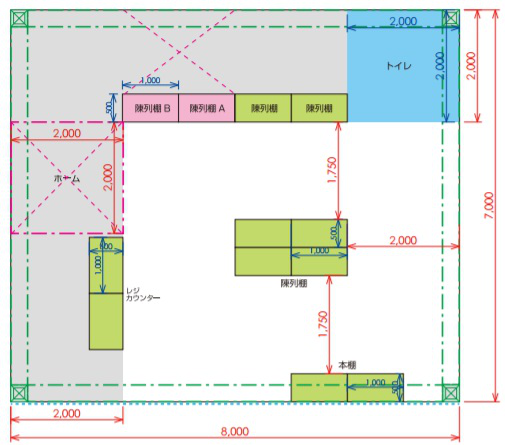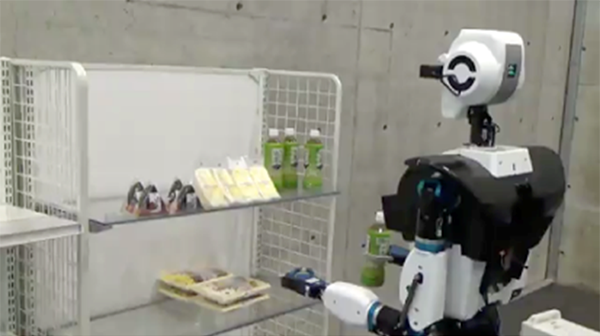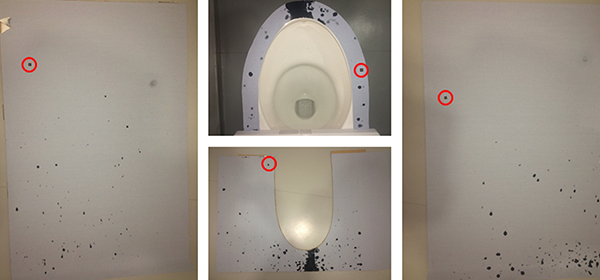October 17-21, 2018 World Robot Summit 2018 | August / October 2020 World Robot Summit 2020
Service Robotics Category
Future Convenience Store Challenge
Outline
We expected participant to compete all the following three tasks.
The participant who execute either one of three tasks are also welcome.
| 1. Stocking and Disposing Tasks Self-stocking of daily products (onigiri rice ball and bento lunch boxes, etc.) and disposing expired products. |
||
| 2. Customer Interaction Task Demonstration of future / sophisticated customer service in near future using robot technology. |
||
| 3. Toilet Cleaning Task Cleaning of the toilet bowl, the floor, and wall in toilet stall. |
||
Detailed rules will be updated as necessary. We will keep you informed about any progress. (Latest version as of Sep.21, 2018).


1. Stocking and Disposing Tasks
This task will use the backyard area, home area, aisle area, Shelf A and Shelf B.
During the demonstration, the teams will
- (1) Line up the products stored inside the container located on Shelf A in the home area
- (2) Organize the products on Shelf B, remove expired products from the shelf and take them to the home area
Flow of competition
Each team will be allocated 20 minutes.
The order of the contest will be
(1) Remodeling time
The participants will remodel the infrastructures and shelves. The following is the list of the tasks that can be done within the time:
- Set up unique infrastructures in the store
- Replace the shelves and the container with unique shelves and container
- Set up unique infrastructures for the products

(2) Set up time
The participants will set up the products and their robots. A total of nine products consisting of three onigiri rice balls, three drinks, and three bento lunch boxes must be stocked up into the container. Participants are free to allocate the robots and the container which keep the products inside as the initial setting in the mockup store. Also the staff will stock the products on Shelf B.
(3) Demonstration of shelf-stocking and disposing of expired products
- The participants will begin operating the system. The robots will pick up products from the container and replenish in the specific area on Shelf A.
- There are five sandwiches on Shelf B. The system must check the best by date on the back of the sandwich label and remove expired products. They must rearrange the rest of the products in the designated position on Shelf B.
- The robots will remove expired foods from the shelf and carry them to the home area.
*The teams can decide how to allocate the time for each item.
2. Customer Interaction Task
The participants can unfold any customer-serving scenario and must demonstrate the system within the allocated time.
Flow of competition
Each team will be allocated 20 minutes.
The order of the contest will be
(1) Remodeling time
The participants will remodel the infrastructure and shelves. The following is the list of tasks should be done within the time:
- Set up unique infrastructures in the store
- Replace the display shelves and the store counter with unique shelves and counter
(2) Set up time
The participants will set up the products and robots. They are free to allocate the robots and products in their initial setting in the mockup store.
(3) Presentation
The participants must explain the overview and the objectives of the system.
*They are allowed to have a presentation with their demonstration simultaneously.
(4) Demonstration of customer interaction
The participants will begin operating the system. The participants are able to create the scenario of customer interaction and must give the demonstration within the allocated time. The following is the list of examples of expected demonstrations:
- Heat up products (such as bento box lunches) and pack it into bags
- Take out hot snacks or cigarettes under the orders by the sales assistants
- Check the gender and age
- Recommend products
- Prevent shoplifting
- Assist the elderly, customers who do not speak the local language, and customers in wheelchairs
- Help customers in the store
*These are only examples of customer interaction and it is not necessary to cover all of the above.
*The participants will appoint the customers.
*The teams can decide how to allocate the time for each item.
3. Toilet Cleaning Task
During the demonstration, the teams will
(1) Clean simulated urine from the toilet (top (rim), sides, bottom of seat), as well as the surrounding floor and walls.
*No need to clean inside the toilet bowl.
(2) Clean the trash on the floor (such as toilet paper and core)
Flow of competition
Each team will be allocated 20 minutes.
The order of the contest will be
(1) Remodeling time
The participants will remodel the infrastructure in the infrastructure area.
(2) Set up time
The participants will set up the mobile robots. They are free to allocate the robots in the home area outside the toilet area.
(3) Toilet cleaning demonstration
The participants will begin operating the system.
- [1] Cleaning mockup urine
The water-spraying device (urinating fountain) will spray 300ml of mockup urine on the opened toilet seat. - [2] Cleaning mockup urine
There will be a total of five pieces of trash consisting of four pieces of toilet paper (maximum 2 cm) and one toilet paper core on the floor at random. The trash will be scattered after spraying the mockup urine.
*The teams can decide how to allocate the time for each item.
Simulation of Urine Discharge (video)

Urine splash Image
(L to R: L wall, toilet seat top (top), floor (bot), rt wall)
